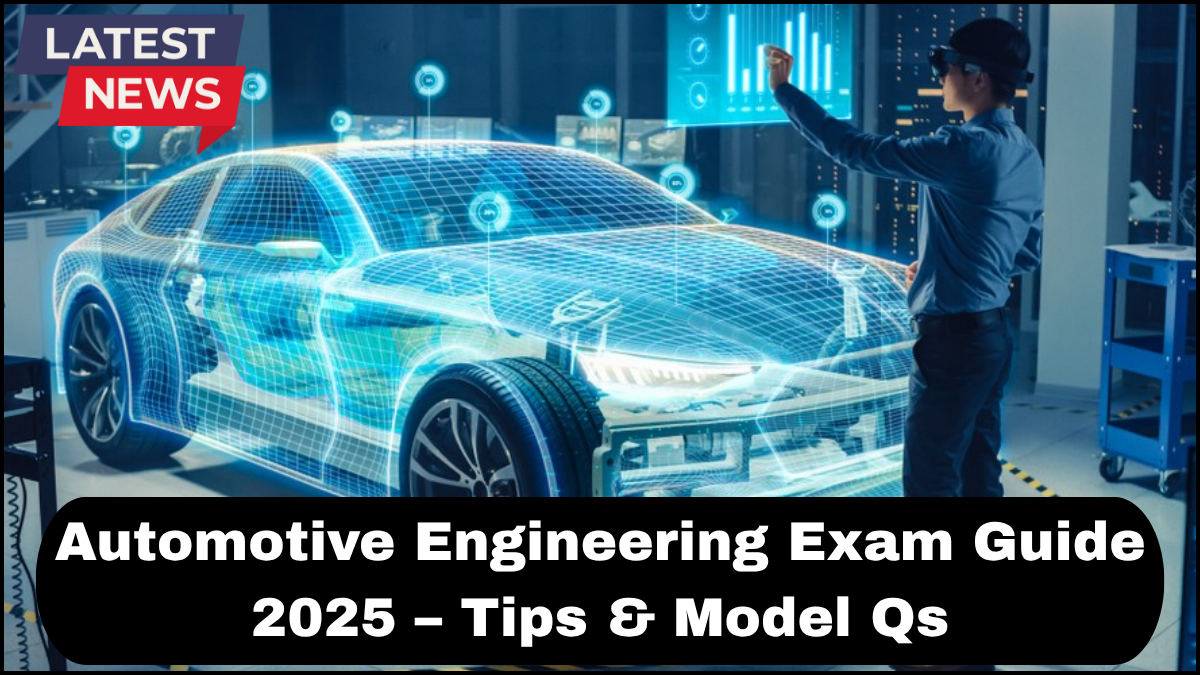Preparing for the Automotive Engineering Exam 2025 demands a clear strategy, a strong grasp of fundamentals, and consistent practice. Whether you’re a final-year undergraduate or a diploma holder aiming for PSU jobs or postgraduate programs, having the right resources and direction can make a significant difference. This Automotive Engineering Exam Guide outlines everything from the latest exam syllabus & tips to essential model questions that reflect current trends in competitive testing.

Understanding the Automotive Engineering Exam Format
Before diving into preparation strategies, it’s crucial to understand the structure of the exam. Although formats vary slightly depending on the institution or board, most Automotive Engineering exams assess both theoretical knowledge and practical applications. Typical components include:
-
Multiple-choice questions (MCQs)
-
Numerical problem-solving
-
Diagram-based questions
-
Short and long-form theoretical answers
Duration typically ranges from 2 to 3 hours, and the scoring system often includes negative marking for objective sections in competitive exams.
Exam Syllabus Overview – 2025 Edition
The Automotive Engineering Exam syllabus covers a blend of mechanical principles, automotive systems, electronics, and emerging technologies. Here’s a breakdown of the core subjects:
1. Automobile Mechanics
-
Internal Combustion Engines (2-stroke & 4-stroke)
-
Transmission systems (manual, automatic, CVT)
-
Braking, steering, and suspension systems
2. Vehicle Dynamics and Control
-
Stability and handling
-
Ride comfort analysis
-
Electronic stability control systems
3. Automotive Electronics
-
ECU architecture and sensors
-
ABS, EBD, and CAN communication protocols
-
Mechatronics in vehicles
4. Thermodynamics and Heat Transfer
-
Laws of thermodynamics
-
Heat exchangers and radiators
-
Fuel combustion efficiency
5. Engineering Drawing and CAD
-
Orthographic and isometric projections
-
Automotive component drafting
-
3D modeling basics using CAD tools
6. Alternative Energy Sources and EVs
-
Battery technologies
-
Hybrid powertrains
-
Hydrogen and fuel cell vehicles
7. Manufacturing Processes
-
Casting, welding, and machining techniques
-
Automotive assembly line logistics
-
Quality control in production
Proven Exam Tips for Success
To ace the Automotive Engineering Exam 2025, preparation needs to go beyond rote learning. Here are effective, actionable strategies:
1. Master the Fundamentals First
Many students overlook the importance of basics. Before tackling advanced topics like autonomous vehicles or EV technologies, be confident in your grasp of mechanical principles.
2. Use Visual Learning
For complex systems like transmissions or suspension geometries, videos, diagrams, and CAD models can help visualize function and interconnectivity. Sketching mechanisms reinforces memory.
3. Time Management
Create a realistic weekly study plan. Allocate more time to high-weightage topics (e.g., IC engines, vehicle dynamics). Break down large chapters into manageable goals.
4. Solve Model Papers Regularly
Practice with previous year question papers and updated model questions. Focus on understanding the logic behind each answer rather than just memorizing facts.
5. Stay Updated with Industry Trends
Modern automotive exams may include questions on current technologies like ADAS, Li-ion batteries, or hybrid propulsion. Reading automotive magazines or watching TED Talks related to mobility can boost your applied knowledge.
6. Group Study & Peer Discussions
Explaining concepts to peers helps reinforce your understanding. Discuss case studies—like comparing hybrid vs. electric vehicle performance—within your study group.
Model Questions for Practice
Q1. Compare Otto and Diesel cycle efficiency for the same compression ratio.
Q2. Explain the function of a differential in a rear-wheel-drive vehicle.
Q3. Draw and explain the working of a McPherson Strut Suspension.
Q4. What are the advantages of regenerative braking in electric vehicles?
Q5. Describe the CAN protocol and its application in automotive electronics.
Q6. Solve: If the compression ratio of an engine is 10:1 and the inlet pressure is 1 bar, calculate the pressure at the end of compression (assume adiabatic process).
FAQs – Automotive Engineering Exam Guide 2025
Q1. What is the best way to cover the entire Automotive Engineering exam syllabus efficiently?
A: Break it into core subjects and tackle one topic at a time. Combine reading with problem-solving and visualize mechanisms whenever possible.
Q2. How many hours should I study per day to prepare effectively?
A: Aim for 4–6 focused hours daily, including at least one hour of revision or practice tests.
Q3. Are software skills like CAD essential for the 2025 exam?
A: Yes, familiarity with CAD and basic drafting is increasingly important, especially for design-based questions and technical interviews.
Q4. Will electric and hybrid vehicle technologies be included in the 2025 syllabus?
A: Absolutely. With the auto industry shifting toward electrification, expect questions on batteries, powertrains, and regenerative systems.
Q5. Is there negative marking in the Automotive Engineering exam?
A: Most competitive formats do include negative marking for MCQs. Always read instructions carefully and avoid blind guessing.
click here to learn more